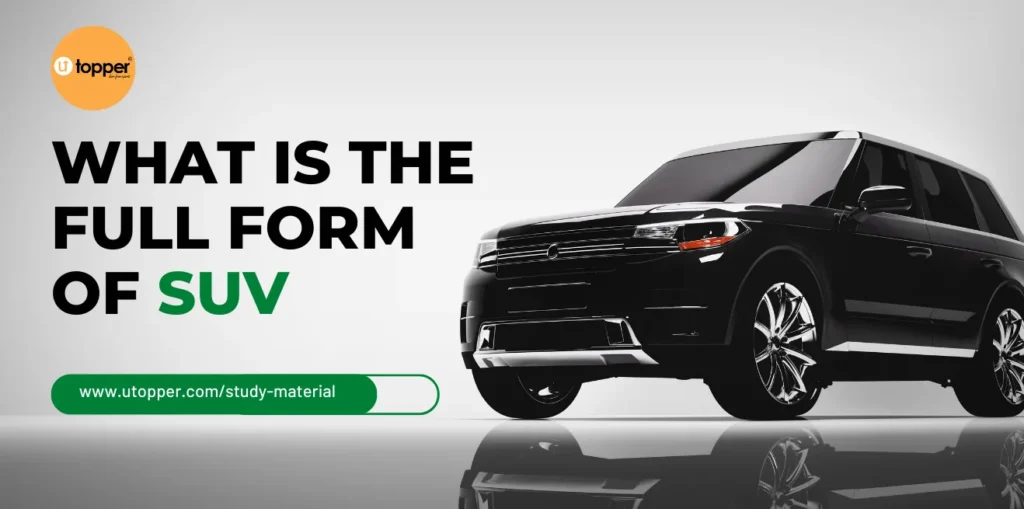SUV Full Form: What Does SUV Stand For?
SUV Full Form – SUV are one of the most popular types of vehicles on the road today, but what exactly does “SUV” stand for? In this article, we will explore the SUV Full Form, its history, types, and benefits.

Read Other Full Forms
What Does SUV Stand For?
SUV stands for “Sport Utility Vehicle.” As the name suggests, these vehicles are designed for both sports and utility purposes, providing a blend of on-road and off-road capabilities. SUVs are generally larger and taller than other types of vehicles, offering more interior space and a higher driving position.
History of SUV
SUVs have been around for over a century, but they were not always as popular as they are today. The first SUV-like vehicle was the 1901 Mercedes Simplex 60 hp, which had a high ground clearance and four-wheel drive. However, it was not until the 1930s that SUVs became more widely available, with the introduction of the Chevrolet Suburban and the International Harvester Travelall.
In the 1980s and 1990s, SUVs became increasingly popular, particularly in the United States, where they were marketed as family vehicles. The Ford Explorer, introduced in 1990, was a particularly successful model, and it helped to establish the SUV as a mainstream vehicle type.
Types of SUV
Today, there are several different types of SUVs available, each with its own set of features and benefits. These include:
Full-size SUVs
Full-size SUVs are the largest and most spacious type of SUV, offering seating for up to eight passengers and plenty of cargo space. They are often used as family vehicles and are popular for their towing capacity and off-road capabilities. Examples include the Chevrolet Tahoe, Ford Expedition, and Toyota Land Cruiser.
Mid-size SUVs
Mid-size SUVs are smaller than full-size SUVs but still offer a good balance of space and utility. They typically seat up to seven passengers and are more fuel-efficient than full-size SUVs. Examples include the Honda Pilot, Toyota Highlander, and Jeep Grand Cherokee.
Compact SUVs
Compact SUVs are smaller than mid-size SUVs and are popular for their versatility and affordability. They are ideal for urban driving and offer a good blend of fuel economy, comfort, and space. Examples include the Honda CR-V, Toyota RAV4, and Nissan Rogue.
Crossover SUVs
Crossover SUVs are a relatively new type of SUV that combines the features of a traditional SUV with those of a car. They are typically smaller and more fuel-efficient than other types of SUVs and offer a smooth and comfortable ride. Examples include the Toyota C-HR, Mazda CX-5, and Hyundai Kona.
Benefits of SUV
SUVs offer several benefits that make them a popular choice for many drivers. Some of these benefits include:
Comfort and space
SUVs are generally more spacious than other types of vehicles, offering plenty of legroom and headroom for passengers. They also have a higher driving position, which can provide a better view of the road ahead.
Off-road capability
Many SUVs are designed for off-road driving, with features such as four-wheel drive and high ground clearance. This makes them ideal for outdoor adventures and rough terrain.
Towing capacity
SUVs are also known for their towing capacity, making them great for carrying heavy loads or towing trailers. They can handle larger items that may not fit in other types of vehicles.
SUV vs. other types of vehicles
SUVs are often compared to other types of vehicles, such as sedans, hatchbacks, and trucks. While they share some similarities with these vehicles, SUVs have some distinct differences.
Compared to sedans and hatchbacks, SUVs offer more space and versatility. They are generally larger and can carry more passengers and cargo. They also have more ground clearance and can handle rough terrain better.
Compared to trucks, SUVs offer more comfort and convenience features. They have better interiors, with more amenities and technology. They are also easier to drive and park in urban environments.
Future of SUV
SUVs are expected to continue to be popular in the coming years, with new advancements in technology and design. Electric and hybrid SUVs are becoming more common, offering improved fuel efficiency and reduced emissions. SUVs are also becoming more connected, with features such as infotainment systems and advanced safety technology.
Conclusion
In conclusion, SUV stands for “Sport Utility Vehicle” and is a type of vehicle that offers a blend of on-road and off-road capabilities. There are several different types of SUVs available, each with its own set of features and benefits. SUVs offer many advantages, including comfort and space, off-road capability, and towing capacity. As technology continues to evolve, SUVs are expected to become even more advanced and popular in the future.
Frequently Asked Questions
Q.1 What is the difference between a crossover and an SUV?
A crossover is a type of SUV that combines the features of a traditional SUV with those of a car. Crossovers are typically smaller and more fuel-efficient than other types of SUVs.
Q.2 Are SUVs more expensive to maintain than other types of vehicles?
SUVs can be more expensive to maintain due to their size and weight. However, maintenance costs can vary depending on the make and model of the SUV.
Q.3 Can SUVs be driven off-road?
Many SUVs are designed for off-road driving, with features such as four-wheel drive and high ground clearance. However, not all SUVs are suitable for off-road driving.
Q.4 How do SUVs compare to minivans?
SUVs are generally larger and more versatile than minivans. They offer more off-road capability and towing capacity, while minivans offer more passenger space and better fuel efficiency.
Q.5 Are SUVs safe to drive?
SUVs can be safe to drive, but it depends on the make and model of the vehicle. Many SUVs come equipped with advanced safety features such as backup cameras, blind-spot monitoring, and lane departure warning.

